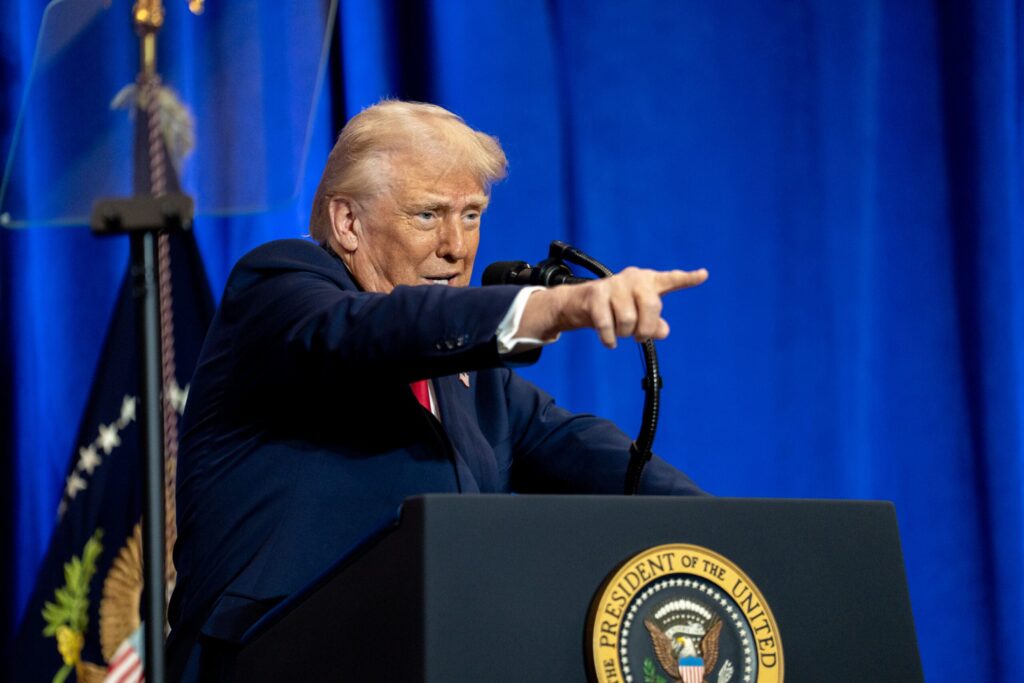Yesterday, the Trump administration announced a series of tariffs it characterized as “reciprocal,” ranging from 10 percent to 50 percent and calculated for every country on Earth. The country-specific rates were made public at the press conference announcing the tariffs, as well as on White House social media.
However, despite the characterization of the tariffs as “reciprocal,” and despite the accompanying graphics referring to foreign “tariffs charged to the USA including currency manipulation and trade barriers,” the White House did not actually measure tariffs, currency manipulation, or trade barrier policies employed by other countries. Instead, it drew its estimates from something else entirely: bilateral trade deficits in goods.
Specifically, the White House documents appear to allege the “tariffs charged to the USA” are the greater of two different quantities: (a) 10 percent, and (b) the 2024 US trade deficit in goods with a given country, divided by the total quantity of US imports from that country.
Set aside, for now, the damage to economic growth these tariffs will cause, or the distributional impact of one of the largest taxA tax is a mandatory payment or charge collected by local, state, and national governments from individuals or businesses to cover the costs of general government services, goods, and activities.
hikes in US history. Other Tax Foundation work will cover that. (We currently estimate the cumulative amount of Trump tariffs at $3.1 trillion over 10 years, amounting to a roughly $2,100 tax increase per household in 2025 alone.)
The method for calculating other countries’ so-called “tariffs” for reciprocal purposes is nonsense. Bilateral deficits are not tariffs, nor are they meaningful anyway; trade in services is relevant; and tariffs cannot be used to target overall trade deficits. The overall result is an extraordinary policy error that will severely damage the economy while failing to reduce the US trade deficit.
The Formula Is Unrelated to Actual Policy
First, the formula. The alleged “tariffTariffs are taxes imposed by one country on goods imported from another country. Tariffs are trade barriers that raise prices, reduce available quantities of goods and services for US businesses and consumers, and create an economic burden on foreign exporters.
rate” from each trading partner is fully a function of trade aggregates, specifically, the deficit divided by US imports, with a minimum of 10 percent. No factors discussed by the administration in these documents or anywhere else (like tariffs, digital services taxes, value-added taxes, or monetary policy) play any role.
For example, Singapore is a relatively free-trade-oriented country, while Brazil makes considerably more use of tariffs and other trade manipulations. However, both end up with the 10 percent rate because of their goods trade balances with the US. By contrast, Vietnam, which exports a great deal to the US but has also worked to make its policies amenable to the US, gets no credit for the effort.
The US response is generally half the alleged rate from other countries, though in some cases it appears to round up an extra percentage point beyond a simple halving.
Bilateral Trade Balances (2024) and Trump’s Tariff Rates, Selected Countries
Note: Selected trading partners only; all figures in millions of dollars.
Source: White House, https://x.com/WhiteHouse/status/1907533090559324204; Census Bureau, “U.S. International Trade in Goods and Services, December 2024,” Feb. 5, 2025, https://www.census.gov/foreign-trade/Press-Release/ft900/ft900_2412.pdf.
The 10 percent minimum number is completely arbitrary and has no derivation. However, the higher numbers are explained in a brief economic policy document published on the website of the US Trade Representative (USTR). The document makes questionable assumptions, but it ultimately derives an expression for how tariffs impact bilateral trade balances.
The alleged tariff rates for other countries flow from this expression with a kind of logic. The USTR document seems to imply that bilateral trade among countries would balance unless there exists a “combination of tariff and non-tariff factors that prevent trade from balancing.” This could be true (in a sense, every factor in the universe is either a tariff or non-tariff factor) but it is not particularly useful unless one believes that bilateral trade should be balanced. Given that bilateral trade isn’t balanced, the logic goes, that is evidence of tariffs or tariff-like factors that deserve retaliation and characterization as “tariffs charged to the USA including currency manipulation and trade barriers.”
The USTR document is primarily focused on what the US should do to make bilateral trade balance, but its expression seems to be used to quantify the alleged tariff rates of other countries as well.
The full expression is slightly more complex than the reduced form discussed thus far; there are actually two parameters: φ and ε, representing the pass-through of tariffs to domestic prices and the elasticity of demand for imports, respectively, but with values of ¼ and 4, respectively, these parameters happen to cancel out perfectly. These parameters are likely difficult to estimate and we will not dwell on them too much, but one point deserves mention: the low value for pass-through is justified with a sentence declaring that “the recent experience with U.S. tariffs on China has demonstrated that tariff passthrough to retail prices was low (Cavallo et al., 2021).” This is not Tax Foundation’s overall read of the literature on tariff pass-through to retail prices, and it is not how we would characterize the results of Cavallo et al., which are considerably more nuanced.
More importantly, this is an equivocation: the foreign “tariff rates” are invented numbers derived from no explicit policies, based on the dubious theoretical assumption that unspecified but retaliation-worthy factors conspired to “prevent trade from balancing.” The US responses are actual tariffs.
Bilateral Trade Balances in Goods Are Not a Good Measure for Tariff Application
Bilateral trade balances are not evidence of malfeasance. Even when they fully reflect economic substance, they should not necessarily balance. And sometimes they do not even reflect economic substance.
Consider a hypothetical example with three countries and three goods:
- Tropical Country produces a surplus of sugar, an adequate amount of lumber, and little wheat.
- Farm Country produces a surplus of wheat, an adequate amount of sugar, and little lumber.
- Forest Country produces a surplus of lumber, an adequate amount of wheat, and little sugar.
Each country would have a strong bilateral imbalance with each other country; Tropical Country would import wheat from Farm Country and export sugar to Forest Country. Farm Country would import lumber from Forest Country and export wheat to Tropical Country. And Forest Country would import sugar from Tropical Country and export lumber to Farm Country. These three countries would be ill-served by creating balanced bilateral trade.
For a real-life example, consider the US trade relationships with the UK and with Indonesia. The UK has a similar climate to many parts of the US, and the US has little need to import many UK goods because it is good at making domestic substitutes. By contrast, Indonesia is a large archipelago of tropical islands, a climate suitable for growing rubber, coconuts, coconut oils, palm oils, coffee, spices, and other goods for which few sites in the US suffice. Are US high imports from Indonesia an indicator of some artificial de-balancing of trade, or a natural consequence of the US having more to gain from Indonesian goods imports?
Moreover, in many cases, bilateral trade does not reflect real economic substance. Sometimes an import or export simply passes through another country before reaching its final destination. A Taiwanese-made lithium-ion battery, for example, might be counted as an exclusively Taiwanese import, but made of expensive materials created in other countries with more mineral resources. In effect, the US is importing from third countries with Taiwan as a layover. On the flipside, many US goods exports nominally destined for Singapore are in fact headed to other final customers throughout the Asia Pacific region.
Finally, there is no good reason to exclude services from the calculation. Foreign payments for aircraft repair or software licenses or restaurant branding rights are legitimate sources of income for Americans.
Tariffs Do Not Close Aggregate Trade Deficits
But even setting aside the specifics of the calculation, and the thorny issues with country-by-country policy, there’s a big-picture problem for those who hope these tariffs will close the US trade deficit. Tariffs tend to fail at this goal because they reduce exports over the long run, either through currency effects or through foreign retaliation.
This is borne out by empirical experience, but it is admittedly unintuitive. In general, one expects that “if you tax something, you get less of it.” Taxing a trade deficit, one might think, would reduce trade deficits. But imports and exports are more symbiotic than that, and their prospects tend to move together. If you tax trade, you get less of it—both imports and exports alike. Even a less-flawed version of Trump’s tariff plan would be unlikely to achieve its goals.
Stay informed on the tax policies impacting you.
Subscribe to get insights from our trusted experts delivered straight to your inbox.
Share this article

